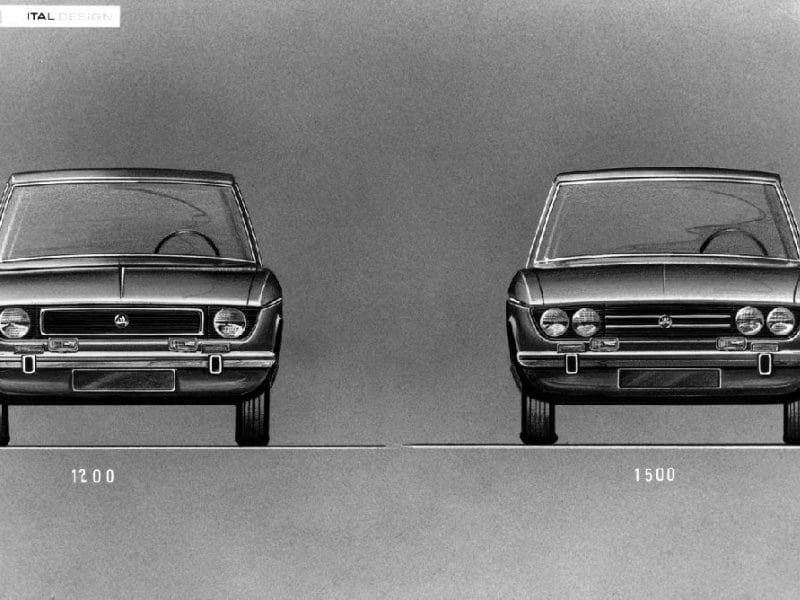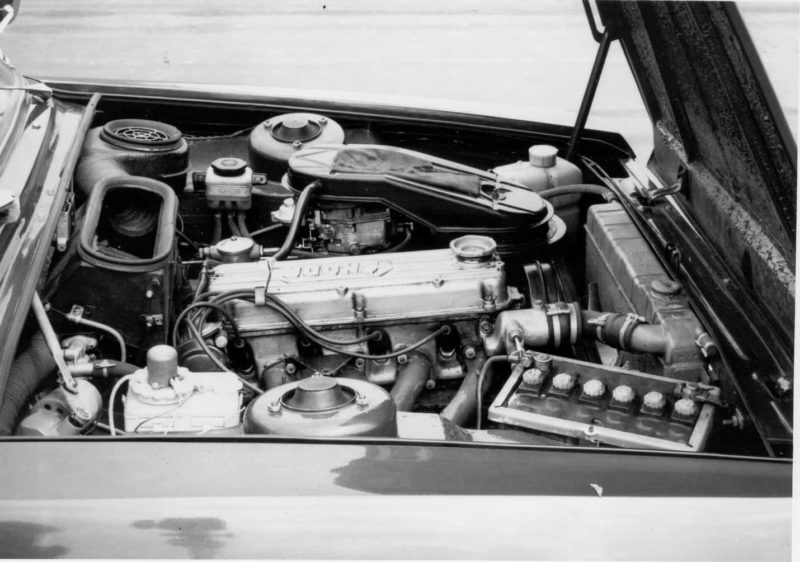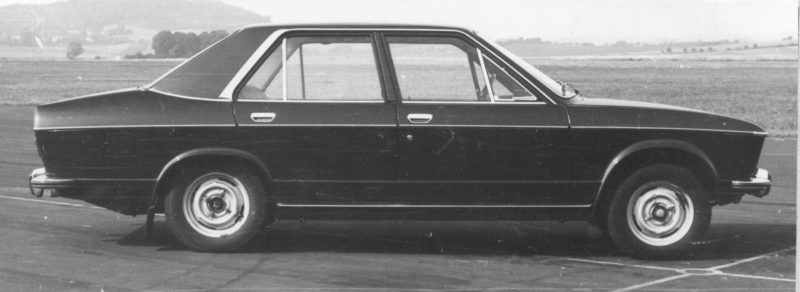It has been twelve years in the making.
Between 1965 and 1977, ŠKODA developed their new mid-sized car under the name 'Project 720'. The car would be positioned above the existing 1000MB and move away from the rear-engined and rear-drive concept.
The new ŠKODA had to take buyers away from customers who opted for cars such as a Taunus, a Rekord, a Simca 1300-1500 or a Fiat 1500. A not too small family sedan, with a choice of an economical 1250 cc, a somewhat more robust 1500 cc and in the future a sturdy 1800 cc four-cylinder in the front. The drive traditionally remained on the rear axle, the Czechs took no risks with front-wheel drive. They did design a modern front train with MacPherson struts and a brand new engine. The car had a length of 4.31 m, a wheelbase of 2,50 m and a mass of 930 kg.
That engine was at the top of its class: aluminum block and head, cross-flow, overhead camshaft and one or two Jikov carburetors licensed from Weber. The 1250 version delivered 65 hp, the 1500 85 hp. That should be seen.

Brand
Then disaster struck. On August 12, 1968, a fire broke out in the interiors department. The factory, which was full of synthetics, carpets, rubbers and glue, caused a blazing conflagration that spread to offices and workshops. The extinguishing lasted two days and nights. When the inspectors were able to view the collapsed halls, it turned out that in addition to the cladding factory, 600 machines had also been lost and the design department with models and mock-ups was lost.
Surprisingly, ŠKODA managed to start production of the new S100-S110 two weeks later, but the new model was put on hold for the time being. The entire three-year investment was lost.
The restart did not come until 1970. Technically they continued on the chosen path, but the bodywork drawn in-house was rejected by the Motokov group (the national exporter of everything on wheels). Too old-fashioned, too much chrome. Ital Design, the design agency of Giorgietto Giugiaro and Aldo Mantovani, was called upon.


Models
Their four-door sedan, two-door hatchback and five-door station wagon could be there! The engineers, sheet metal workers, painters and welders got to work and 1971 samples of the sedan were built in 1972 and 60, to start the road tests. The earlier design of the interior was abandoned, instead the test cars were fitted with matte black dashboards with the well-known PAL built-in meters and 'stove knobs'.

The second blow came in 1973. During an International Comecon Congress, or whatever it was called, the Czechoslovak government had agreed with the GDR government that AZMB (ŠKODA) and VEB Automobilwerk Eisenach (Wartburg) should work together on a new middle class. Independent thinking and working was no longer allowed. The East German Wartburg still used the pre-war three-cylinder two-stroke, while ŠKODA had a new four-stroke. The political deal was soon closed. Now for the technical details.

Not that they felt like it, in Mlada Boleslav! Older employees had not forgotten that ŠKODA had been renamed 'Reichswerke Hermann Göring' during the war, which mainly involved robbery, forced labor and Jewish employees who never returned. In 1945 the Germans had taken what they could and destroyed everything they had to leave behind. Maybe there were other things at play. Anyway, it didn't click. The collaboration failed miserably. Project 720 once again went into a deep drawer.

Out of the mothballs again
The project was restarted in 1975. ŠKODA was planning to introduce the new S105-S120 series by then, which was actually not much different from a modernized S100-S110. Funny to see that style elements of the 720 can still be seen in the 741, the S105-S120. But the auto press began to be a bit sneering at the once-proud car brand. Another engine in the back, and pendle axles. It was now the last of the Mohicans.
Customers also wanted to be able to take a little more than just a few suitcases and overnight bags. Because even though the front door of the new models hinged to the side so conveniently, there was not much luggage space and not everyone was warm to the ŠKODA 1203 van (which, incidentally, did end up with the new 1500cc engine). This is how the plan was born to at least test the 720 model as a station wagon.
This resulted in a few test models with the well-known 1500 engine and styling adapted to the times. The car was ready for production by 1977. And again the plug went out. Why this time? Nobody knows. In any case, the country's party leadership and government did not excel at exploiting the technical potential in their factories.

Meanwhile, the gray veil of standstill had descended over Eastern and Central European countries. In the once industrially powerful GDR, nothing new was developed after the 60s. The FSO Polonez still appeared in Poland, a modern appearance, but still a Fiat 1500 from 1961 under the skin. And so the communist world in Europe faltered in its last decade. Old Renaults came from Romania and Bulgaria, old Fiats from Yugoslavia. And the USSR was also quite on the automotive gum: their most successful car remained the now ancient Lada and their least successful the much more modern Aleko. In all those countries the politicians became grey, the achievements invisible, the streets gray and the products scarce. It was not until the very end of the 80s that ŠKODA introduced the Favorit, which was largely developed under its own steam. The West could once again be looked straight in the eye. And then the Wall fell.
What if 'Project 720' and 'Project 765' could have counted on a little more party support? Then ŠKODA could have taken a nice bite out of the Western European market. It wasn't supposed to be.
Next step?
Of the sixty ŠKODA 720 units built, three are still on the road. All three with the 1500 engine. A 1250 can be admired in the ŠKODA Museum in Mlada Boleslav. Two copies of the station wagons have been preserved and none of the hatchback.

Still German
In 1990, after communist governments fell across Eastern Europe, the new government decided to split its property, the huge ŠKODA factories in Prague, Kvasini, Pilsen and Mlada Boleslav, and look for partners. The car factory received offers from Volkswagen and from a consortium of Volvo and Renault. The Czechs foresaw disaster if their old brand reverted to an assembly plant, as had happened with Wartburg. (In Eisenach, after a mass layoff, Opel Vectras were now being screwed together.) A demand was therefore that ŠKODA build its own staalfawould retain its foundry and processing plants (engines and gearboxes are the heart of production) and its own R&D department. The brand wanted to continue to develop its own models at all costs, otherwise they would go from the communist rain to the capitalist drip.
Fortunately that didn't happen. Volkswagen completed the takeover and the old brand is very much alive.





An Audi 80 Nsu ro80 and another Vw K70 also come pretty close in terms of construction and age, but they borrowed it nicely from Skoda
This Skoda is very similar to the Fiat 132. Designed by Gandini. I don't know if this design is from the same time or if Gandini drew it for Giugiaro. Project 720's engine was successfully used by Czech autocross racers such as Martin Medáček.
Gandini did not care about his safety for Giugiaro.
Both of them could not lead themselves.
Allerdings were both nacheinander bei Bertone angestellt,
Giugiaro zuerst und nachdem der Bertone verlassen hatte, comb Gandini.
Wenn anyway, then Gandini has für Bertone gezeichnet.
I once read that 'they' in the Eastern Bloc were not allowed to pass the boss. The Boss was the USSR that still struggled with old models and techniques. They did not want initiatives from the satellite states that undermined central power.
The article also mentioned a modern front-wheel drive compact car from the GDR that was banned by the 'boss' and ended up on the copy machine via via (out of engineer's frustration) in Wolfsburg. Anyway, the Golf became a BRD success as a VW, as is known.
I can't find anything more about it. Maybe it would be nice for AMK to find out in journalism how this worked at the time?
From the end of 1985 to 1988 I was a PR advisor to De Binckhorst Handelsmaatschappij in Voorschoten, at the time the only customer who could be reached on foot in 10 minutes. At that time, the import of Skoda and Polonez played the leading role. In 1988, a dealer trip went to Mlada Boleslav and I was driven to the head office in Prague to ask my opinion on how to organize the launch of the Favorit – when, where and how. I recommended the Paris Salon. At that office I got a pile of documentation with prints from the Laurin & Klement. I made a booklet of this that was published by Voiture's Courant, for which I wrote after the separation from Het Automobiel. These publications later ended up at Wilbers Publishing.
The Favorit and the Forman came late, but they were good cars. And yet, as crazy as it sounds, the old Skodas with engine and rear drive had something special. They were solidly built, you could feel it, and they were much more spacious on the inside than you might think from the outside. They were noisy but the engines sounded really nice. The shifting and steering was fine. In short, they had character.
The same applies to Renault 8/10, Simca1000, VW1200 etc. But with the drive and the weight behind it was a lot of work in bad weather to reach your goal unscathed 🤨
Then everything was a bit more comfortable in the front.
Looks a lot like a car I've owned: Fiat 131 Mirafiori
But that only came a few years later. In terms of design, the cars from that time are also very similar, with their rather angular designs. You can also see touches of various other German and Italian models.
It is a pity that Škoda at the time could never release these models with modern technology due to party-driven mismanagement, but was left with the "trench wagon". Fortunately, the Czech pride has been restored, the cars are even more beautiful than those of the parent company
True, and looking back from 2021 it seems as if time in Eastern Europe has always stood still, but that is not quite right. Because until the end of the sixties, the peasant and worker states were fully renovated and of course there was a period of reconstruction there too.
Look at the GDR: the Trabi 601 in 1964, the Wartburg 1000 in 1966. In the USSR the Moskvitch 408 and 412, the Volga M24 and the Zaporozhets 966. Skoda also introduced new models after Czechoslovakia became communist and built between 1959 and 1964 one of the most modern factories in Europe at the time. Those cars didn't cut a bad figure at all in the XNUMXs, but they were all endlessly produced.
Yet the 131 Mirafiori was not designed by ItalDesign Giugiaro. But it's a compliment that the Skoda resembled the beautiful Fiat.
It seems that Volkswagen has looked to the East with the design of the K70 ...
Nope, the K70 was an NSU legacy. The K stood for Kolbenmotor, piston engine, and the 70 for horsepower. That to distinguish it with the Rotationsmotor of 80hp, the NSU Ro80.
Nice story of the last Skoda models, as the son of a seventies Skoda Coupe 110R father…..
The Skoda S110R was a nice car, often it was parked in a driveway as a second car. They weren't expensive, drove well and looked good, but they were very poorly protected against rust. That was because they were not made in Mlada Boleslav's modern factory, but in a factory from the horse-drawn tram era, in Kvasini. There was no modern phostat bath, no wax preservation of cavities and no robot spraying line that didn't miss a spot.
But that innocent coupe was a rally cannon in the 130RS version. With that engine, a 101 hp OHC 200-valve engine, the car went over 130 km/h and won every race including the Monte Carlo Rally, the Acropolis Rally, the European Touring Car Championship and I believe ten times the RAC rally. The 180RS was derived from the unique 200RS and XNUMXRS.
Would you like to point this out to everyone who is laughing about the old Skoda? 😀